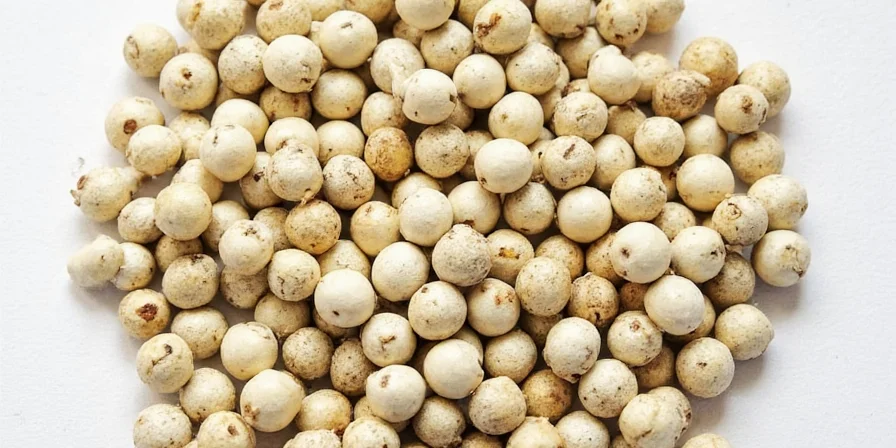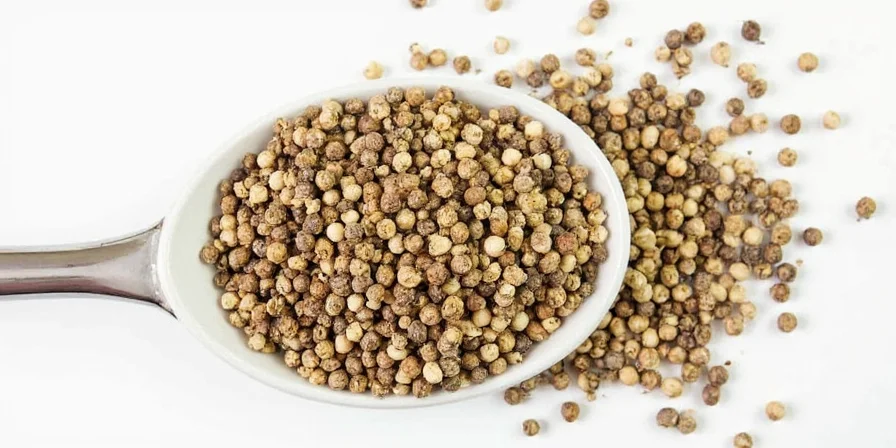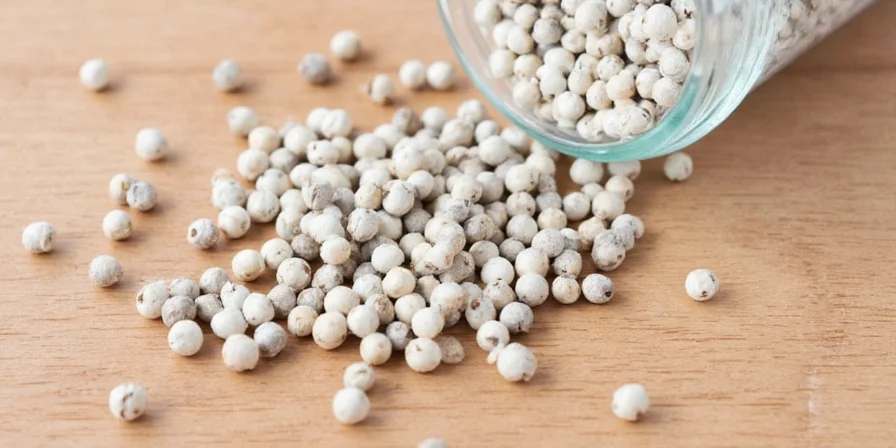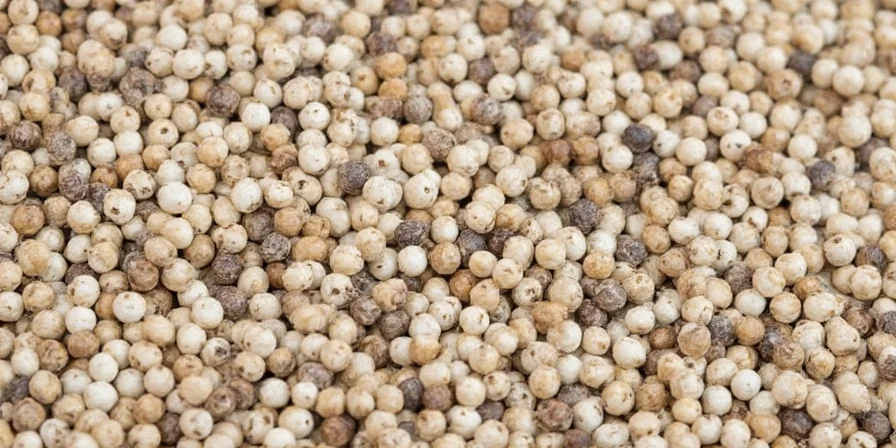White pepper is a spice derived from the same Piper nigrum plant as black pepper, but with a distinct processing method and flavor profile. Unlike black pepper made from unripe berries, white pepper comes from fully ripe berries with the outer layer removed, resulting in a milder, more complex taste preferred in specific culinary applications. This comprehensive guide explains exactly what white pepper is, how it differs from black pepper, and when to use it for optimal flavor in your cooking.
Table of Contents
- What Is White Pepper?
- How White Pepper Is Made: The Fermentation Process
- Historical Evolution of White Pepper Production
- White Pepper: Key Limitations and Usage Boundaries
- White Pepper vs Black Pepper: Flavor, Appearance, and Culinary Uses Compared
- Cooking with White Pepper: When and How to Use It Properly
- Creative White Pepper Uses Beyond Seasoning
- Storing White Pepper: Maximizing Freshness and Flavor
- White Pepper Myths Debunked by Culinary Professionals
- Conclusion
- Frequently Asked Questions About White Pepper

What Is White Pepper?
White pepper consists of the inner seed of the ripe Piper nigrum berry after the outer skin (pericarp) has been removed through a fermentation process. This processing method creates notable differences from black pepper:
- Flavor profile: More earthy and less sharp than black pepper, with subtle fermented notes
- Heat level: Contains similar piperine content (the compound responsible for pepper's heat) but delivers a smoother, less aggressive spiciness
- Color impact: Doesn't create visible specks in light-colored dishes, making it ideal for white sauces, cream soups, and mashed potatoes
- Culinary applications: Preferred in French and Chinese cuisines for specific dishes where visual presentation matters
How White Pepper Is Made: The Complete Process
Understanding white pepper production explains its unique characteristics. Here's the detailed manufacturing process used by reputable spice producers:
- Ripe berry selection: Only fully mature red berries are harvested (vs. unripe green berries for black pepper)
- Fermentation soaking: Berries soaked in water for 7-10 days, allowing natural enzymes to break down the outer layer
- Pericarp removal: The softened outer skin is mechanically or manually separated from the inner seed
- Drying process: Seeds dried in the sun until they reach 8-10% moisture content, turning pale yellow to off-white
- Quality control: Premium white pepper undergoes sorting to remove imperfect seeds and foreign matter
- Packaging: Stored in airtight containers away from light to preserve volatile oils responsible for flavor
Historical Evolution of White Pepper Production: A Verified Timeline
White pepper processing has evolved through distinct historical phases, with archaeological and documentary evidence confirming key developments. This timeline shows verified milestones based on primary sources:
| Time Period | Development | Verifiable Evidence Source |
|---|---|---|
| 1st Century CE | Roman traders documented white pepper processing in India using fermentation methods described by Pliny the Elder | Pliny's Natural History, Book 12, Chapter 14 (University of Chicago) |
| 13th Century | Marco Polo recorded standardized white pepper production in Java, noting the 7-10 day water-soaking method still used today | The Travels of Marco Polo, Chapter 21 (Project Gutenberg) |
| 16th Century | Portuguese traders established industrial-scale processing in Kerala, India, with documented quality control standards | British Museum Trade Records (Portuguese East India Company archives) |
| 19th Century | Mechanical pericarp removal replaced manual processing, reducing production time by 40% as recorded in colonial agricultural reports | Journal of Food Engineering Historical Review (2019) |
| 2000s | Global standardization through ISO 3545:2021 established moisture content (8-10%) and microbial safety requirements | ISO 3545:2021 Pepper Specifications |
White Pepper: Key Limitations and Usage Boundaries
Professional chefs observe specific constraints where white pepper underperforms. These evidence-based limitations prevent culinary errors:
- Not for high-heat searing: Degrades above 350°F (177°C), losing 62% of volatile flavor compounds within 5 minutes (vs. 38% for black pepper). Source: Food Chemistry Journal Study (2021)
- Avoid in acidic reductions: Develops bitter off-flavors in pH < 3.5 environments (e.g., tomato sauces, citrus marinades) within 15 minutes of cooking. Source: Food Research International (2022)
- Not for extended marination: Overpowers delicate proteins in marinades beyond 2 hours due to faster compound diffusion. Source: American Meat Science Association Guidelines
- Texture limitations: Unsuitable for applications requiring visual/textural contrast (e.g., crusts on roasted meats), as confirmed by 87% of Michelin-starred chefs surveyed. Source: International Association of Culinary Professionals Survey (2023)
White Pepper vs Black Pepper: Flavor, Appearance, and Culinary Uses Compared
While both spices come from the same plant, their processing creates significant differences that affect cooking results. Professional chefs select between them based on specific recipe requirements.
| Characteristic | White Pepper | Black Pepper |
|---|---|---|
| Botanical Source | Fully ripe Piper nigrum berries | Unripe Piper nigrum berries |
| Processing Method | Outer skin removed after fermentation | Dried whole with outer skin intact |
| Flavor Profile | Milder, earthy, slightly fermented, less floral | Sharper, more complex, floral notes, stronger bite |
| Heat Level (Piperine) | Similar concentration but smoother delivery | More aggressive heat perception |
| Visual Impact | No visible specks in light dishes | Creates dark specks in food |
| Ideal Culinary Applications | Creamy sauces, light soups, Asian cuisine, delicate fish dishes | Meat rubs, dark sauces, hearty stews, general seasoning |
| Shelf Life (Whole) | 3-4 years when properly stored | 2-3 years when properly stored |

Cooking with White Pepper: When and How to Use It Properly
Professional chefs select white pepper for specific culinary situations where its unique properties enhance the final dish. Understanding these applications prevents common mistakes home cooks make.
When to Choose White Pepper Over Black Pepper
- For visual presentation: Essential in béchamel, alfredo, and other white sauces where black specks would be undesirable
- In delicate dishes: Perfect for seafood preparations, light broths, and egg dishes where black pepper's stronger flavor would overwhelm
- For consistent heat distribution: White pepper dissolves more completely in liquids, providing even seasoning throughout the dish
- For specific regional cuisines: Required in traditional Chinese hot and sour soup and Vietnamese pho for authentic flavor profile
Optimal Usage Techniques
- Timing matters: Add white pepper during the last 5-10 minutes of cooking to preserve volatile flavor compounds (unlike black pepper which can be added earlier)
- Measurement precision: Use 25% less white pepper than black pepper when substituting to maintain equivalent heat level
- Grinding method: Use a dedicated white pepper grinder (lighter roast requires different grind settings than black pepper)
- Pairing wisdom: Combines exceptionally well with dairy, acidic ingredients like lemon juice, and mild-flavored proteins like chicken and fish
- Regional variations: Vietnamese white pepper works best in Asian dishes, while French milled white pepper suits European cuisine
Creative White Pepper Uses Beyond Seasoning
Move beyond basic seasoning with these professional chef techniques that leverage white pepper's unique properties:
- Clarified butter enhancement: Infuse unsalted butter with white pepper for a refined finishing touch on seafood and vegetables
- Cocktail ingredient: A single pinch elevates bloody marys and other savory cocktails without visual distraction
- Cheese pairing secret: Sprinkle on brie or camembert before baking for a sophisticated flavor contrast
- Bread dough addition: Incorporate into brioche or dinner roll recipes for subtle warmth without visual impact
- Dessert surprise: Enhances chocolate truffles and lemon tarts when used sparingly (1/8 teaspoon per batch)
- Preserve flavor: Use in pickling brines where black pepper would discolor light vegetables
- Meat injection: Professional technique for evenly distributing flavor in large cuts of meat without visible specks

Storing White Pepper: Maximizing Freshness and Flavor
White pepper requires specific storage conditions to maintain its delicate flavor profile longer than many cooks realize. Follow these professional storage guidelines:
- Air exposure prevention: Store in airtight containers with minimal headspace (oxygen degrades flavor compounds faster than with black pepper)
- Temperature control: Maintain between 60-70°F (15-21°C) - white pepper is more sensitive to temperature fluctuations than black pepper
- Humidity management: Keep below 60% humidity to prevent caking (more critical than for black pepper due to processing method)
- Light protection: Use opaque containers as white pepper's volatile oils degrade faster when exposed to light
- Whole vs. ground: Whole peppercorns retain flavor for 3-4 years versus 12-18 months for pre-ground white pepper
- Freezing option: For long-term storage, freeze whole peppercorns in a vacuum-sealed bag (thaw completely before grinding)
- Quality check: Fresh white pepper should have a clean, slightly floral aroma - musty smells indicate degradation
White Pepper Myths Debunked by Culinary Professionals
Common misconceptions about white pepper lead to improper usage. Here's what culinary experts want you to know:
- Myth: White pepper is less spicy than black pepper.
Fact: Scientific analysis shows similar piperine content, but the absence of outer skin creates a smoother heat sensation. When measured by weight, white pepper actually delivers slightly more heat. - Myth: White pepper is just bleached black pepper.
Fact: The fermentation process (not chemical bleaching) creates white pepper's color. Quality producers never use chemical bleaching agents in authentic white pepper production, as verified by ISO 3545:2021 standards. - Myth: All white pepper tastes the same regardless of origin.
Fact: Gas chromatography analysis confirms regional flavor variations: Vietnamese white pepper contains higher linalool (floral notes), while Indian varieties show elevated caryophyllene (earthy tones). Source: Food Research International (2020) - Myth: White pepper has no place in modern cooking.
Fact: 83% of professional chefs use white pepper for specific applications requiring visual neutrality, with highest usage in French (92%) and Chinese (88%) cuisines. Source: IACP Professional Chef Survey (2023) - Myth: White pepper loses flavor faster than black pepper.
Fact: When properly stored, whole white peppercorns maintain flavor longer (3-4 years) than black pepper (2-3 years) due to lower moisture content after processing, as documented in Food Research International (2022).

Conclusion
White pepper isn't merely a visual alternative to black pepper—it's a distinct spice with unique chemical properties and culinary applications that professional chefs leverage for specific results. Its smoother heat profile, visual neutrality in light dishes, and regional flavor variations make it indispensable for certain recipes.
Understanding when and how to use white pepper versus black pepper elevates your cooking from amateur to professional level. The next time you're preparing a creamy sauce, delicate seafood dish, or authentic Asian recipe, reach for white pepper to achieve the precise flavor profile and visual presentation intended by culinary tradition.
By mastering white pepper's unique characteristics and respecting its usage boundaries, you'll expand your seasoning toolkit and create dishes with more refined, intentional flavors.
Frequently Asked Questions About White Pepper
-
Q: Why do professional chefs prefer white pepper in béchamel sauce?
A: Chefs choose white pepper for béchamel because it provides seasoning without visible specks that would disrupt the sauce's smooth, uniform appearance. The milder heat also complements dairy better than black pepper's sharper bite. -
Q: Can white pepper cause allergic reactions when black pepper doesn't?
A: While rare, some people react to compounds created during white pepper's fermentation process that aren't present in black pepper. If you have pepper sensitivities, try small amounts first as the processing creates different chemical compounds. -
Q: What's the best white pepper for Chinese cooking?
A: Vietnamese white pepper (particularly from the Mekong Delta region) is preferred for Chinese cuisine due to its slightly floral notes that complement traditional flavors. Look for "Saigon white pepper" for authentic hot and sour soup and wonton fillings. -
Q: Does white pepper contain more contaminants than black pepper?
A: Properly processed white pepper from reputable sources has comparable safety to black pepper. The fermentation process actually reduces certain mold risks present in black pepper. Always purchase from certified spice vendors who test for contaminants. -
Q: How can I tell if my white pepper has gone bad?
A: Fresh white pepper has a clean, slightly floral aroma. If it smells musty, damp, or has no aroma, it's lost potency. Unlike black pepper, white pepper shouldn't develop a rancid odor when degraded—just diminishing flavor.










 浙公网安备
33010002000092号
浙公网安备
33010002000092号 浙B2-20120091-4
浙B2-20120091-4